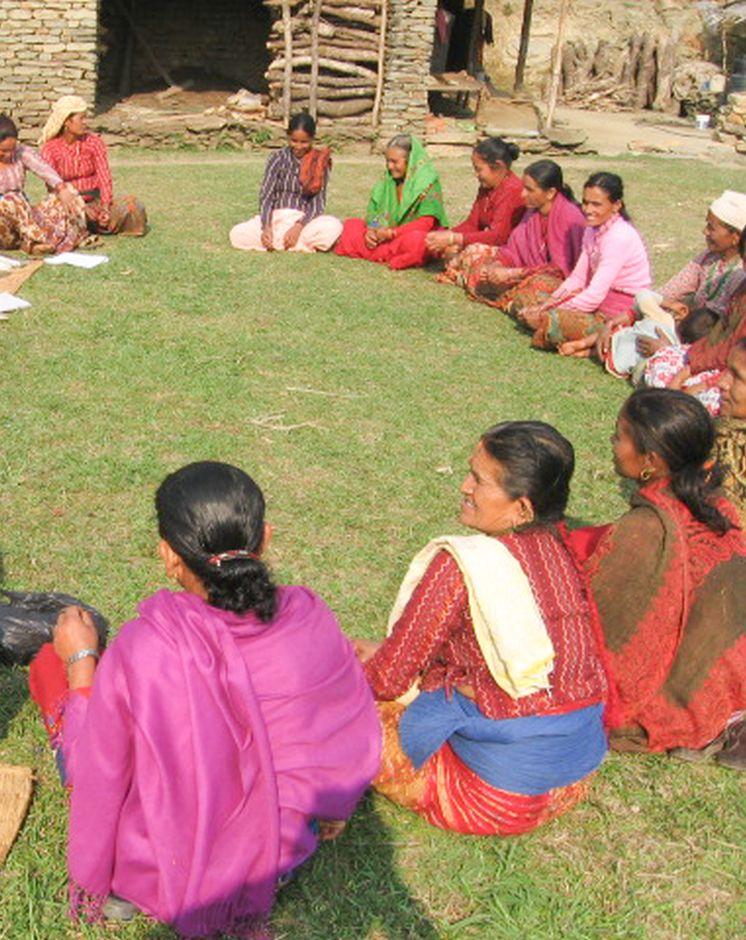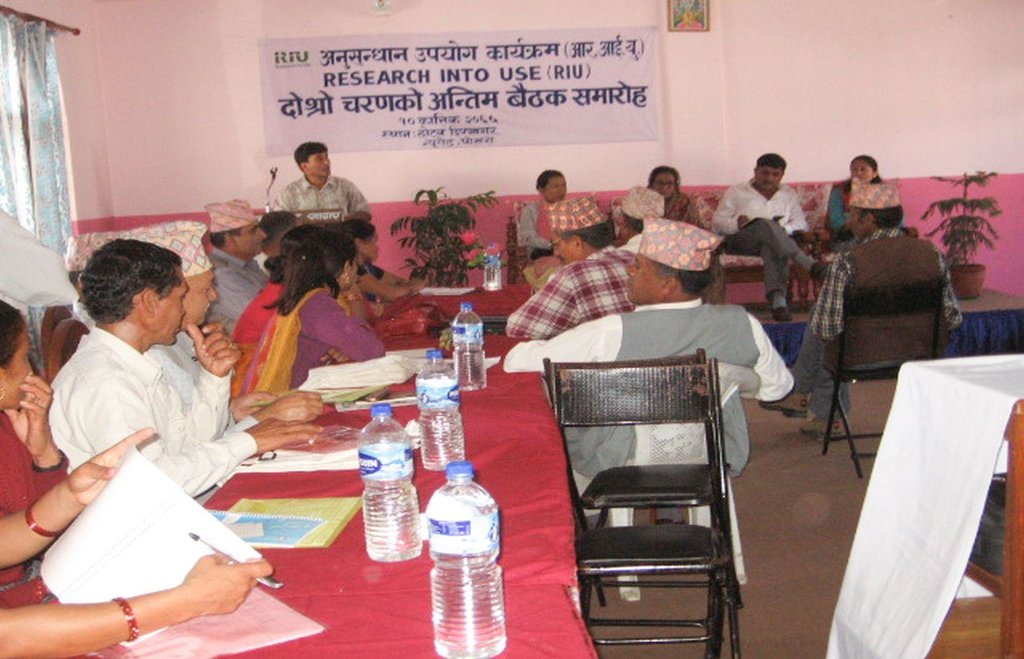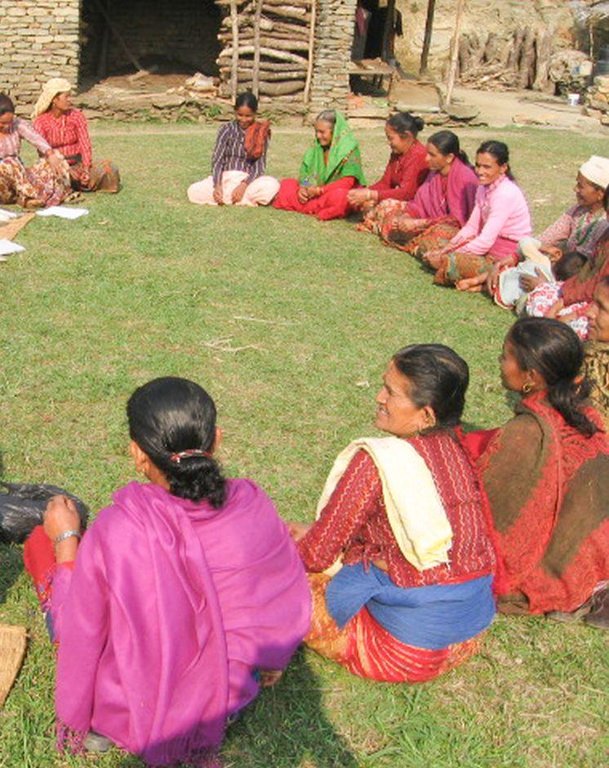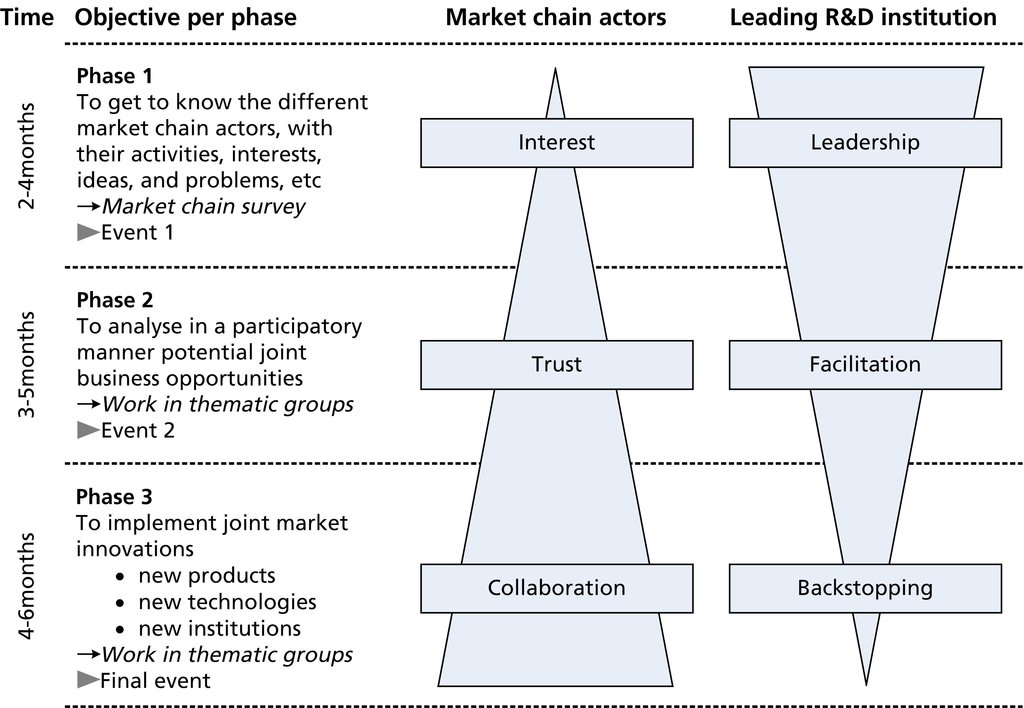Using the participatory market chain approach to help smallholder farmers market their produce [النيبال]
- تاريخ الإنشاء:
- تحديث:
- جامع المعلومات: Shreedip Sigdel
- المحرر: –
- المُراجع: Fabian Ottiger
tarakari sahachetrama sahabhagitatmak bajar sanjal bidhi ko prayog (Main Contributor: Bharat Nepal, IDE/Nepal)
approaches_2533 - النيبال
عرض الأقسام
توسيع الكل طي الكل1. معلومات عامة
1.2 تفاصيل الاتصال بالأشخاص الرئيسيين لمصدر المعلومات والمؤسسات المعنية بتقييم وتوثيق النهج
متخصص في الإدارة المستدامة للأراضي:
Nepal Bharat
+977 61526537, +977 15520943 (KTM)
bnepal@idenepal.org
International Development Enterprises (IDE) Nepal, Research Into Use (RIU) Project
Regional Office, Pokhara, Kaski; PO Box No. 2674, Kathmandu, Nepal
النيبال
اسم المؤسسة (المؤسسات) التي سهلت توثيق/تقييم النهج (إذا كان ذلك على صلة)
ICIMOD International Centre for Integrated Mountain Development (ICIMOD) - النيبالاسم المؤسسة (المؤسسات) التي سهلت توثيق/تقييم النهج (إذا كان ذلك على صلة)
iDE Nepal (iDE Nepal) - النيبال1.3 الشروط المتعلقة باستخدام البيانات الموثقة من خلال WOCAT
متى تم تجميع البيانات (ميدانيا)؟:
01/03/2013
يوافق جامع المعلومات والشخص (لاشخاص) الرئيسي لمصدر المعلومات على الشروط المتعلقة باستخدام البيانات الموثقة من خلال WOCAT:
نعم
1.4 المراجع الخاصة باستبيان(استبيانات) تقنيات الإدارة المستدامة للأراضي
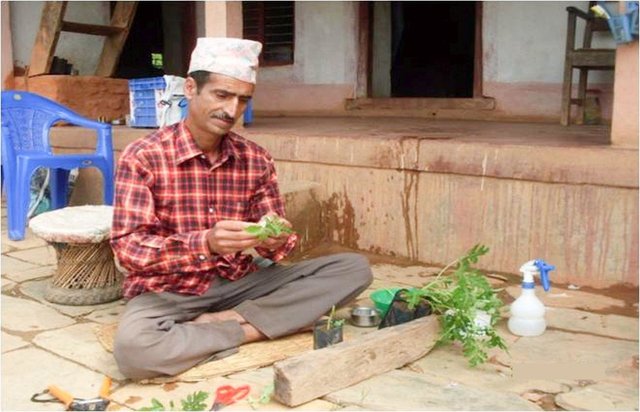
Tomato Grafting [النيبال]
Cleft grafting can be used to produce plants that are resistant to a number of pests and diseases and are often higher yielding than the original. Tomato seedlings can be easily grafted onto resistant root stock of the wild eggplant (Solanum sysimbrifolium) to produce a disease-resistant and commercially viable crop.
- جامع المعلومات: Shreedip Sigdel
2. وصف نهج الإدارة المستدامة للأراضي
2.1 وصف موجز للنهج
Discussions and structured interactions between farmers and the different actors involved throughout the market chain can help to stimulate joint innovations based on shared ideas and mutual trust.
2.2 وصف تفصيلي للنهج
وصف تفصيلي للنهج:
Aims / objectives: Most Nepalese rural smallholder landowners are subsistence farmers; when they attempt to produce high value crops such as vegetables for income generation they are often disappointed because they end up selling their produce at local markets for marginal profits. They mostly work alone and, for the most part, their efforts are poorly rewarded, since every step of the value chain is either unmanaged, badly structured, or otherwise uncoordinated. A first step towards addressing the myriad challenges and special needs faced by these smallholder farmers can be to use an adapted version of the participatory market chain approach (PMCA). This approach can help them to improve their livelihoods by building their capacity and assisting them to coordinate and form linkages with other smallholder producers and actors all along the market chain.
Methods: The participatory market chain approach uses the tools of rapid market assessment, focus group discussions, stakeholder interviews, and interaction workshops to help identify the constraints and opportunities faced by each of the different actors in the market chain. This approach uses a set of guidelines to help achieve well-defined objectives at specific points as the programme is implemented.
Stages of implementation: Overall, the long-term objective of the PMCA is to help alleviate the poverty of smallholder producers by introducing market chain innovations, and in particular participation and collaboration among the different market chain actors. Once a given set of conditions is found to work, they can benefit a larger number of farmers if the findings are documented and disseminated among organizations and agencies who share the same goals.
The PMCA approach is executed in three phases:
Phase 1: The different actors along the market chain get to know each other. They analyse their situation with the help of market chain sketch tools. By the end of Phase 1, they form a thematic group.
Phase 2: The group analyses potential business opportunities by using a variety of tools such as: rapid market appraisal, quantitative market survey/study, and focus group discussions.
Phase 3: They put into practice the work plan that they have devised to implement the proposed innovations and continue to work on ideas for commercially viable products using the market concept and business plan development tools.
2.3 صور عن النهج
2.5 البلد/المنطقة/المواقع التي تم تطبيق النهج فيها
البلد:
النيبال
مزيد من التفاصيل حول الموقع:
Bhalam and Dhikurpokhari VDC, Kaski District,
2.7 نوع النهج
- قائم على مشروع/برنامج
2.8 الغايات/الأهداف الرئيسية للنهج
The Approach focused mainly on other activities than SLM (marketing of agricultural commodities)
• Develop collection centres at the local level
• Strengthen linkages with the concerned development agencies, service providers, and related market chain actors
• Help smallholder farmers to work with a market-led production plan
• Summarize and share the information gathered with the concerned development organizations in order to scale up the approach
• Develop an action plan based on discussions held with thematic group members and market chain actors
The SLM Approach addressed the following problems: • At the local level, the markets are poorly structured and poorly managed; there is a lack of systematic marketing for agricultural commodities.
• There is little knowledge of post-harvest processing which would add value to agricultural produce.
• The links and coordination between service providers, market actors, and stakeholders are poor.
• There is insufficient knowledge of institutional development and of the import role it plays in getting products to market.
• Smallholder farmers do not have access to pricing information.
• Distrust and misunderstanding prevail at every step along the market chain.
2.9 الظروف التي تمكن أو تعيق تنفيذ التقنية/التقنيات المطبقة بموجب النهج
المعايير والقيم الاجتماعية /الثقافية/ الدينية
- معيق
Smallholder producers have little experience selling their produce at larger markets.
Treatment through the SLM Approach: Strengthen community-based collection centres for collective marketing.
توفر/الوصول إلى الموارد والخدمات المالية
- معيق
There is no support that smallholder farmers can count on to market their produce.
Treatment through the SLM Approach: Inform farmers of the possibility of participating in programmes like PMCA to extend their networking.
الإطار المؤسساتي
- معيق
Weak institutional collaboration among line agencies; market and planning committees only function irregularly.
Treatment through the SLM Approach: Facilitate better management of market and planning committees so that the local collection centre can function well.
الإطار القانوني (حيازة الأراضي، وحقوق استخدام الأراضي والمياه)
- تمكين/تمكيني
The approach does not deal specifically with water or land use rights. When these are problematic they are referred to the concerned authorities on a case-by-case basis.
المعرفة حول الإدارة المستدامة للأراضي، والوصول إلى الدعم الفني
- معيق
Inadequate information on market-led production and post-harvest processing; poor links with markets.
Treatment through the SLM Approach: Disseminate pricing information; provide training on postharvest processing; give smallholder farmers an opportunity to visit commercial vegetable production sites and different market outlets and allow them to interact with market chain actors and other land users.
غير ذلك
- معيق
Distrust, misunderstanding and poor communication are prevalent in interactions between smallholder farmers, traders, service providers, and those in development agencies.
Treatment through the SLM Approach: Facilitate frequent interactions between vegetable producers, market and planning committee members, and traders to help break down barriers and build trust; facilitate the development of plans for joint implementation.
3. المشاركة وأدوار الأطراف المعنية
3.1 أصحاب المصلحة المعنيون بالنهج وأدوارهم
- مستخدمو الأراضي المحليون/المجتمعات المحلية
A majority of the participants (>60%) were women who are involved at different points along the market chain. More than 20% who participated are from disadvantaged groups.
- متخصصون في الإدارة المستدامة للأراضي / مستشارون زراعيون
- منظمة غير حكومية
- منظمة دولية
3.2 انخراط مستخدمي الأراضي المحليين/المجتمعات المحلية في المراحل المختلفة للنهج
| انخراط مستخدمي الأراضي المحليين/المجتمعات المحلية | حدد من شارك وصف الأنشطة | |
|---|---|---|
| المبادرة/التحفيز | تفاعلي | Public meetings, focus group discussions, interviews, market surveys and rapid market assessments, impact filters |
| التخطيط | التعبئة الذاتية | Market constraints and opportunities are identified; actors throughout the market chain and members of thematic groups develop future plans based on their assessment of the business potential for local products and services. |
| التنفيذ | التعبئة الذاتية | The PMCA is implemented through the Marketing Planning Committee and collection centres by various actors from throughout the market chain and members of the various thematic groups; skilled staff from the R&D organization helps with facilitation. |
| الرصد/التقييم | التعبئة الذاتية | Members of the various thematic groups and the MPC jointly monitor and evaluate plans and achievements on a regular basis. |
| Research | تفاعلي | The approach is applied by the thematic groups. R&D organizations help these groups to analyse both quantitative and qualitative information. |
3.3 مخطط التدفق (إذا كان متاحًا)
الوصف:
The PMCA approach facilitates and promotes trust among market chain actors and allows them to work together to introduce innovative new ideas. During the initial phase, it is usually R&D organizations that take the lead, but as the approach matures, there is an ever greater involvement of the community. The PMCA process supports the development and implementation of institutional, technological, and commercial innovations and has acted to promote constructive interactions through mutual learning and trust.
(AK Thaku)
3.4 اتخاذ القرار بشأن اختيار تقنية/تقنيات الإدارة المستدامة للأراضي
حدد من الذي قرر اختيار التقنية/التقنيات التي سيتم تنفيذها:
- متخصصون في الإدارة المستدامة للأراضي بشكل أساسي، بعد التشاور مع مستخدمي الأراضي
اشرح:
Initially, the choice of the PMCA approach was made by national and international specialists in consultation with local people. It was first offered by a research and development organization, but as everyone came to see how valuable it was, it was eventually taken on by local people and is now offered by various groups to everyone throughout the market chain.
Decisions on the method of implementing the SLM Technology were made by mainly by SLM specialists with consultation of land users
4. الدعم الفني وبناء القدرات وإدارة المعرفة
4.1 بناء القدرات/التدريب
هل تم تقديم التدريب لمستخدمي الأراضي / الأطراف المعنيين الآخرين؟:
نعم
حدد من تم تدريبه:
- مستخدمو الأراضي
- موظفون ميدانيون/ مستشارون
شكل التدريب:
- من مزارع إلى مزارع
- مناطق العرض
- اجتماعات عامة
- دورات
4.2 خدمة استشارية
هل يملك مستخدمو الأراضي وصولا إلى خدمة استشارية؟:
نعم
حدد ما إذا كانت الخدمة الاستشارية متوفرة:
- في مراكز دائمة
وصف/تعليقات:
Name of method used for advisory service: Training and workshop; Key elements: a market-led production plan, technical training for the thematic groups and regular monitoring of land users' fields, facilitation of joint programme planning and implementation.
4.3 تعزيز المؤسسات (التطوير التنظيمي)
هل تم إنشاء أو تعزيز مؤسسات من خلال هذا النهج؟:
- نعم، باعتدال
حدد المستوى (المستويات) التي تم فيها تعزيز أو إنشاء المؤسسات:
- محلي
حدد نوع الدعم:
- بناء القدرات/التدريب
اعط مزيدا من التفاصيل:
The groups that were given market-centred training, and technical training on high value vegetable production and post harvest processing. Participants included members of village development committees, local governance and community development programmes (LCGDP), community forest users' groups, youth clubs, and women's groups.
4.4 الرصد والتقييم
هل يشكل الرصد والتقييم جزءا من النهج؟:
نعم
التعليقات:
technical aspects were monitored through observations; indicators: Commercial production and collective marketing
socio-cultural aspects were monitored through observations; indicators: This approach increased their bargaining power and made them aware of current market prices for their high-value products.
economic / production aspects were monitored through observations; indicators: Market-led production and the application of post harvest processing techniques
area treated aspects were monitored through observations; indicators: The Marketing Planning Committee surveyed the area.
no. of land users involved aspects were monitored through observations; indicators: Some 200–750 farmers were involved in the Market Planning Committee and the collection centre.
management of Approach aspects were monitored through observations; indicators: Various actors from all along the market chain participated; regular observations were made and training was given to facilitate the implementation of innovative activities.
There were several changes in the Approach as a result of monitoring and evaluation: The focus was on the collective marketing of smallholder farmers' vegetable produce. These farmers now work towards market-led production through regular meetings and trainings; they market collectively, and have better post-harvest processing. It is helping to empower women and members of disadvantaged groups and to improve their livelihoods.
4.5 البحوث
هل كانت البحوث جزءًا من النهج؟:
نعم
أعط تفاصيل إضافية وأشر إلى من قام بالبحوث:
This approach is the result of research which took place in Peru and Uganda. It has been adapted to the vegetable sub- sector in Nepal by IDE Nepal in collaboration with local NGOs. Both the government of Nepal and other local NGOs are in the process of adopting and piloting what was learned.
5. التمويل والدعم المادي الخارجي
5.1 الميزانية السنوية لمكون الإدارة المستدامة للأراضي في النهج المذكور
إذا لم تكن الميزانية السنوية الدقيقة معروفة، قم بالإشارة إلى نطاقها:
- 10,0000-2,000
التعليقات (على سبيل المثال المصادر الرئيسية للتمويل/الجهات المانحة الرئيسية):
Approach costs were met by the following donors: international non-government: 60.0%; private sector: 10.0%; local government (district, county, municipality, village etc): 10.0%; local community / land user(s): 20.0%
5.2 الدعم المالي/المادي المقدم لمستخدمي الأراضي
هل حصل مستخدمو الأراضي على دعم مالي/ مادي لتنفيذ التقنية/ التقنيات؟:
نعم
5.3 إعانات لمدخلات محددة (بما في ذلك العمالة)
إذا كان العمل من قبل مستخدمي الأراضي مدخلاً جوهريًا، فهل كان:
- تطوعي
التعليقات:
The project demonstrated new agricultural technologies only once; after that, the various groups adopted new technologies at their own cost.
5.4 الائتمان
هل تم توفير ائتمان في إطار نهج أنشطة الإدارة المستدامة للأراضي؟:
كلا
6. تحليل الأثر والتصريحات الختامية
6.1 آثار النهج
هل ساعد النهج مستخدمي الأراضي على تنفيذ وصيانة تقنيات الإدارة المستدامة للأراضي؟:
- لا
- نعم، قليلا
- نعم، باعتدال
- نعم، إلى حد كبير
In districts where the farmers have adopted organic vegetable production, there has been a noted retention of good soil fertility. Valam VDC of Kaski District is one such example.
هل ساهم النهج في تمكين الفئات المحرومة اجتماعيا واقتصاديا؟:
- لا
- نعم، قليلا
- نعم، باعتدال
- نعم، إلى حد كبير
Smallholder farmers are commonly the poorest and most disadvantaged members of any community, and they have benefited from this approach.
Did other land users / projects adopt the Approach?
- لا
- نعم، قليلا
- نعم، باعتدال
- نعم، إلى حد كبير
The agricultural component of the Market Access for Smallholder Farmers (MASF) Project which is implemented by IDE (and funded by DFID) has adopted this approach. District level line agencies such as LI-BIRD have also adopted it. Districts in the Eastern Region that adopted agricultural crop and goat programmes include Bara, Rautahat, Siraha, and Saptari Districts.
Did the Approach lead to improved livelihoods / human well-being?
- لا
- نعم، قليلا
- نعم، باعتدال
- نعم، إلى حد كبير
When everyone along the market chain collaborates through shared interests and mutual trust to bring better produce to a common market - everyone benefits from the increased opportunities.
Did the Approach help to alleviate poverty?
- لا
- نعم، قليلا
- نعم، باعتدال
- نعم، إلى حد كبير
When smallholder farmers sell their produce at collection centres for a fair price they earn more income and, as a result, their livelihoods are improved and poverty is reduced.
6.3 استدامة أنشطة النهج
هل يمكن لمستخدمي الأراضي المحافظة على استدامة ما تم تنفيذه من خلال النهج (بدون دعم خارجي)؟:
- نعم
إذا كانت الإجابة بنعم، صف كيف:
The approach can be replicated without external support. Once a core group of smallholder farmers understands the approach, they can pass on the know-how to others through regular meetings and other vehicles. The establishment of the collection centre is an activity that should yield benefits for a long time to come.
6.4 نقاط قوة/مزايا النهج
| نقاط القوة/ المزايا/ الفرص من وجهة نظر جامع المعلومات أو غيره من الاشخاص الرئيسيين لمصدر المعلومات |
|---|
| Everyone along the market chain is involved in making decisions about the choice of high value crops and their marketing. (How to sustain/ enhance this strength: It is important to continue the regular meetings in order to assure the continued success of the present activities and to introduce innovations.) |
|
The PMCA has proven that it can be a valuable tool for all stakeholders along the market chain to help them design and implement programmes. (How to sustain/ enhance this strength: Lobby the government and other agencies to replicate the PMCA in other areas and agencies.) |
| The approach helped to build relationships and trust among the market chain actors and it led to increased vegetable production and increased earnings for farmers. (How to sustain/ enhance this strength: Upgrading the market planning committee to a cooperative would help to generate more resources from the members.) |
| Farmers sell their produce through the collection centre in a collective marketing approach. (How to sustain/ enhance this strength: If this approach is documented and disseminated, other areas of the country can learn from it and replicate it.) |
6.5 نقاط الضعف/ العيوب في المنهج وطرق التغلب عليها
| نقاط الضعف/ المساوىء/ المخاطر من وجهة نظر جامع المعلومات أو غيره من الاشخاص الرئيسيين لمصدر المعلومات | كيف يمكن التغلب عليها؟ |
|---|---|
|
Smallholder farmers cannot always produce enough high value crops to sell profitably; it can be a challenge to transport crops to the collection centre. |
Farmers need time and support in order to learn how to adopt commercial farming methods and how to market their produce collectively |
| When only smallholder farmers are involved, the meetings of the thematic groups can be sporadic. | Need to involve commercial farmers in the thematic groups. |
|
The PMCA process has not been well documented for replication. |
Clear documentation is necessary so that the results can be replicated in other areas. |
| Smallholder farmers often do not have the means to implement innovations. | Provide some seed money for thematic groups; development organizations who plan to implement the PMCA approach can provide this. |
7. المراجع والروابط
7.1 طرق جمع/مصادر المعلومات
- زيارات ميدانية، مسوحات ميدانية
- مقابلات مع مستخدمي الأراضي
7.2 المراجع للمنشورات المتاحة
العنوان، المؤلف، السنة، النظام القياسي الدولي لترقيم الكتب ISBN:
Participatory market chain approach (PMCA): user guide (unpublished). Kathmandu, Nepal: IDE Nepal, RIU Project, Thomas, T; Graham, T; Thomas, Z (no date)
الروابط والوحدات المواضيعية
توسيع الكل طي الكلالروابط

Tomato Grafting [النيبال]
Cleft grafting can be used to produce plants that are resistant to a number of pests and diseases and are often higher yielding than the original. Tomato seedlings can be easily grafted onto resistant root stock of the wild eggplant (Solanum sysimbrifolium) to produce a disease-resistant and commercially viable crop.
- جامع المعلومات: Shreedip Sigdel
الوحدات المواضيعية
لا يوجد وحدات مواضيعية


